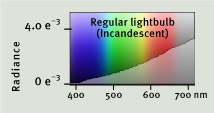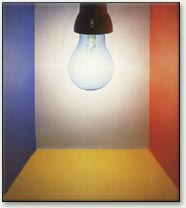A page from the "Causes of Color" exhibit...
What does our eye see in different lights?


Spectra of light reflected from a piece of white paper. Units of radiance in W/m2/sr/nm.

Different light bulbs create very different colors.
You’ve probably experienced the inviting warmth of a living room and the harsh coldness of, say, a doctor’s office. What you see (and how you interpret it) often depends upon the source of light.
Different illuminants
What we see depends on the illuminant. The most common type of light is the standard tungsten light bulb. Halogen light and candlelight are very similar, with halogen having a slightly steeper onset in the short-wave region, and candlelight having a concave, almost exponentially rising curve. When electric current passes through the gas of a fluorescent light, it produces ultraviolet light, which strikes a phosphor coating, making it fluoresce. An overcast sky creates a different kind of light. The light of a blue sky has a flatter spectrum across all wavelengths, whereas the light coming from grey clouds at midday is more intense in the middle and long-wave regions than in the short-wave region. Dips occurring at 690, 730 and 760 nm are typical for all daylight spectra and probably indicate the absorption spectra of compounds such as water. An additional kind of lamp, used frequently in offices, stores, and to light public spaces, is the vapor lamp. Vapor lamps contain a gas under low pressure, but the gas glows with visible light when electricity passes though it. The color of the light depends on the gas. The first electric lamps, arc lamps, were first developed in the early 1800s. Later in the 19th century, the filament light bulb and the vapor lamp were developed. See the sections on incandescent light bulbs, vapor lamps, and color constancy for more information.
Following is a summary of the colors seen in the light box above.
|
||||||||||||||||||||



